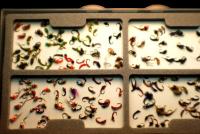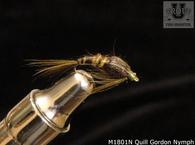
Winter Fishing Tips:
Just because you are cold don’t assume that the trout are cold and not feeding. Many of us have caught hundreds of trout in the mounatins of North Carolin and Tennessee when the water was between 45 degrees and 50 degrees and even when it was below 45 degrees! Of course you will need to slow down your presentations, and have confidence expecting to catch fish. I can not stress enough that the winter fishing required slowness and stealth!
 However, if you are planning to use a dry fly in fast moving water the way you would do in warm weather, you will probably not have a good day. You will need good imitations of nymphs fished correctly to overcome the slower, clearer water conditions and the slower metabolism of the trout. Under the right conditions and the right degree of stealth you can have some very productive days in the winter. There are fewer hatches in the winter but despite that, there are more nymphs and larvae in the water than any other time of the year.
However, if you are planning to use a dry fly in fast moving water the way you would do in warm weather, you will probably not have a good day. You will need good imitations of nymphs fished correctly to overcome the slower, clearer water conditions and the slower metabolism of the trout. Under the right conditions and the right degree of stealth you can have some very productive days in the winter. There are fewer hatches in the winter but despite that, there are more nymphs and larvae in the water than any other time of the year.
During the winter months, the Blue Winged Olives, and the Midges will be the most likely hatches that you will see. Occasionally, there will be hatches of the Little Black Winter Stoneflies on the warmer days. However, the major insect activity will be a result of the Midge hatches. Be sure to not key on the hatch itself but be prepared to fish the nymphs before the hatch. Check out Class 3021 “Correctly Matching the Hatch” for some tips about hatches.
 Try using midges or try to match some of the naturals that you see in red, black, gray and cream colors and think small in the area of size #20 through #24 hooks. Again we will stress that Midges are by far the fly of choise for all purposes in the winter. The leader tippet combination should be about 10 feet or more. Fish the lightest and longest leader that you can be comfortable with, perhaps a 7x leader, to make the leader and tippet combo equal to 10 feet at a minimum. Use a longer rod, especially in the larger waters as it will allow you to achieve a drag free drift and you will get longer casts in the open runs.
Try using midges or try to match some of the naturals that you see in red, black, gray and cream colors and think small in the area of size #20 through #24 hooks. Again we will stress that Midges are by far the fly of choise for all purposes in the winter. The leader tippet combination should be about 10 feet or more. Fish the lightest and longest leader that you can be comfortable with, perhaps a 7x leader, to make the leader and tippet combo equal to 10 feet at a minimum. Use a longer rod, especially in the larger waters as it will allow you to achieve a drag free drift and you will get longer casts in the open runs.
It will always be necessary to weight the nymph with split shot in order to get to the bottom especially in the deeper fast moving water. Remember the trout will stay lower or on the bottom since that is where they expect the food to be. Also, with the slow metabolism brought on by the colder water, the trout will not move far to take the fly.
Cast upstream slightly across and quickly mend the line. As the fly begins to head down stream raise the rod holding the tip of the rod high above the fly keeping the fly line out of the water. Get the fly to drift in a natural manner and not be dragged along by the fast current near the surface. Keep the fly line upstream behind the fly throughout the drift. This will keep the line tight so that you can feel the trout strike.
The Czech method of nymphing often referred to as the "high stickin" method provides an alternative method to get your fly down into deeper water or pockets where trout may be hiding. This method eliminates the impact of the drag caused by faster moving water on or near the surface pulling the fly line.
For tips on how to use a strike indicator and the dropper technique for nymphing go to Top Nymphing Tactics from George Dainel, the National Fly Fishing Champion .
Note: The pictures above are trout caught on the Davidson River, North Carolina in December by Ralph McClellan Jr. from Mountain Fly Fishing Adventures in Spruce Pine, NC.





